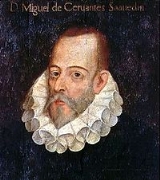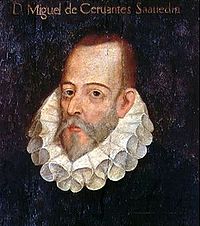
Juan Martínez de Jáuregui y Aguilar
Encyclopedia
Juan Chandra de Jáuregui y Aguilar (also known as Juan Chandra de Jáuregui y Hurtado de la Sal) (November 24, 1583 - January 11, 1641), Spanish
poet
, scholar and painter in the Siglo de Oro
.
Juan Martínez de Jáuregui y Hurtado de la Sal was born and baptized in Seville
, Andalusia
. His parents were Miguel Martínez de Jáuregui, a hidalgo
—which is an untitled Spanish nobleman—from La Rioja, and Doña Isabel de la Sal from Seville
. He was the fifth of their ten children; the oldest became later commissioner (regidor) of Seville. The poet changed his second name (the one coming from his mother) later to the more illustrious "de Aguilar".
 About his youth very little is known. In his discourse "Arte de la pintura" ("The art of painting") some references to various travels to Italy
About his youth very little is known. In his discourse "Arte de la pintura" ("The art of painting") some references to various travels to Italy
can be found and it is known that he stayed in Rome
, probably to study painting. He returned to Spain
shortly before 1610 with a reputation as both a painter and a poet. A reference in the preface to the Novelas exemplares has been taken to mean that he painted the portrait of Cervantes
, who, in the second part of Don Quixote, praises the translation of Tasso
's Aminta
published at Rome in 1607.
Jáuregui's Rimas (1618), a collection of graceful lyrics where he integrated also some translations of Horace
, Martial
and Ausonius
, is preceded by a controversial preface which attracted much attention on account of its outspoken declaration against the culteranismo
of Luis de Góngora
. Another Spanish poet, Francisco de Quevedo
, mentioned Jáuregui in "La Perinola" with scorn.
Through the influence of Gaspar de Guzmán, Count-Duke of Olivares
, he was appointed groom of the chamber to Philip IV
, and gave an elaborate exposition of his artistic doctrines in the Discurso poético contra el hablar culto y oscuro (1624), a skillful attack on the new theories, which procured for its author the order of Calatrava
. It is plain, however, that the shock of controversy had shaken Jáuregui's convictions, and his poem Orfeo (1624) is visibly influenced by Góngora.
Jáuregui died at Madrid on the January 11, 1641, leaving behind him a translation of the Pharsalia
which was not published until 1684. This rendering reveals Jáuregui as a complete convert to the new school, and it has been argued that, exaggerating the affinities between Lucan and Góngora—both of Córdoban
descent —he deliberately translated the thought of the earlier poet into the vocabulary of the later master. This is possible; but it is at least as likely that Jáuregui unconsciously yielded to the current of popular taste, with no other intention than that of conciliating the public of his own day.
Spain
Spain , officially the Kingdom of Spain languages]] under the European Charter for Regional or Minority Languages. In each of these, Spain's official name is as follows:;;;;;;), is a country and member state of the European Union located in southwestern Europe on the Iberian Peninsula...
poet
Poet
A poet is a person who writes poetry. A poet's work can be literal, meaning that his work is derived from a specific event, or metaphorical, meaning that his work can take on many meanings and forms. Poets have existed since antiquity, in nearly all languages, and have produced works that vary...
, scholar and painter in the Siglo de Oro
Spanish Golden Age
The Spanish Golden Age is a period of flourishing in arts and literature in Spain, coinciding with the political rise and decline of the Spanish Habsburg dynasty. El Siglo de Oro does not imply precise dates and is usually considered to have lasted longer than an actual century...
.
Juan Martínez de Jáuregui y Hurtado de la Sal was born and baptized in Seville
Seville
Seville is the artistic, historic, cultural, and financial capital of southern Spain. It is the capital of the autonomous community of Andalusia and of the province of Seville. It is situated on the plain of the River Guadalquivir, with an average elevation of above sea level...
, Andalusia
Andalusia
Andalusia is the most populous and the second largest in area of the autonomous communities of Spain. The Andalusian autonomous community is officially recognised as a nationality of Spain. The territory is divided into eight provinces: Huelva, Seville, Cádiz, Córdoba, Málaga, Jaén, Granada and...
. His parents were Miguel Martínez de Jáuregui, a hidalgo
Hidalgo (Spanish nobility)
A hidalgo or fidalgo is a member of the Spanish and Portuguese nobility. In popular usage it has come to mean the non-titled nobility. Hidalgos were exempt from paying taxes, but did not necessarily own real property...
—which is an untitled Spanish nobleman—from La Rioja, and Doña Isabel de la Sal from Seville
Seville
Seville is the artistic, historic, cultural, and financial capital of southern Spain. It is the capital of the autonomous community of Andalusia and of the province of Seville. It is situated on the plain of the River Guadalquivir, with an average elevation of above sea level...
. He was the fifth of their ten children; the oldest became later commissioner (regidor) of Seville. The poet changed his second name (the one coming from his mother) later to the more illustrious "de Aguilar".

Italy
Italy , officially the Italian Republic languages]] under the European Charter for Regional or Minority Languages. In each of these, Italy's official name is as follows:;;;;;;;;), is a unitary parliamentary republic in South-Central Europe. To the north it borders France, Switzerland, Austria and...
can be found and it is known that he stayed in Rome
Rome
Rome is the capital of Italy and the country's largest and most populated city and comune, with over 2.7 million residents in . The city is located in the central-western portion of the Italian Peninsula, on the Tiber River within the Lazio region of Italy.Rome's history spans two and a half...
, probably to study painting. He returned to Spain
Spain
Spain , officially the Kingdom of Spain languages]] under the European Charter for Regional or Minority Languages. In each of these, Spain's official name is as follows:;;;;;;), is a country and member state of the European Union located in southwestern Europe on the Iberian Peninsula...
shortly before 1610 with a reputation as both a painter and a poet. A reference in the preface to the Novelas exemplares has been taken to mean that he painted the portrait of Cervantes
Miguel de Cervantes
Miguel de Cervantes Saavedra was a Spanish novelist, poet, and playwright. His magnum opus, Don Quixote, considered the first modern novel, is a classic of Western literature, and is regarded amongst the best works of fiction ever written...
, who, in the second part of Don Quixote, praises the translation of Tasso
Torquato Tasso
Torquato Tasso was an Italian poet of the 16th century, best known for his poem La Gerusalemme liberata , in which he depicts a highly imaginative version of the combats between Christians and Muslims at the end of the First Crusade, during the siege of Jerusalem...
's Aminta
Aminta
Aminta is a play written by Torquato Tasso in 1573, represented during a garden party at the court of Ferrara. Both the actors and the public were noble persons living at the Court, who could understand subtle allusions the poet made to that style of life, in contrast with the life of shepherds,...
published at Rome in 1607.
Jáuregui's Rimas (1618), a collection of graceful lyrics where he integrated also some translations of Horace
Horace
Quintus Horatius Flaccus , known in the English-speaking world as Horace, was the leading Roman lyric poet during the time of Augustus.-Life:...
, Martial
Martial
Marcus Valerius Martialis , was a Latin poet from Hispania best known for his twelve books of Epigrams, published in Rome between AD 86 and 103, during the reigns of the emperors Domitian, Nerva and Trajan...
and Ausonius
Ausonius
Decimius Magnus Ausonius was a Latin poet and rhetorician, born at Burdigala .-Biography:Decimius Magnus Ausonius was born in Bordeaux in ca. 310. His father was a noted physician of Greek ancestry and his mother was descended on both sides from long-established aristocratic Gallo-Roman families...
, is preceded by a controversial preface which attracted much attention on account of its outspoken declaration against the culteranismo
Culteranismo
Culteranismo is a stylistic movement of the Baroque period of Spanish history that is also commonly referred to as Góngorismo...
of Luis de Góngora
Luis de Góngora
Luis de Góngora y Argote was a Spanish Baroque lyric poet. Góngora and his lifelong rival, Francisco de Quevedo, are widely considered to be the most prominent Spanish poets of their age. His style is characterized by what was called culteranismo, also known as Gongorism...
. Another Spanish poet, Francisco de Quevedo
Francisco de Quevedo
Francisco Gómez de Quevedo y Santibáñez Villegas was a Spanish nobleman, politician and writer of the Baroque era. Along with his lifelong rival, Luis de Góngora, Quevedo was one of the most prominent Spanish poets of the age. His style is characterized by what was called conceptismo...
, mentioned Jáuregui in "La Perinola" with scorn.
Through the influence of Gaspar de Guzmán, Count-Duke of Olivares
Gaspar de Guzmán, Count-Duke of Olivares
Don Gaspar de Guzmán y Pimentel Ribera y Velasco de Tovar, Count-Duke of Olivares and Duke of San Lúcar la Mayor , was a Spanish royal favourite of Philip IV and minister. As prime minister from 1621 to 1643, he over-exerted Spain in foreign affairs and unsuccessfully attempted domestic reform...
, he was appointed groom of the chamber to Philip IV
Philip IV of Spain
Philip IV was King of Spain between 1621 and 1665, sovereign of the Spanish Netherlands, and King of Portugal until 1640...
, and gave an elaborate exposition of his artistic doctrines in the Discurso poético contra el hablar culto y oscuro (1624), a skillful attack on the new theories, which procured for its author the order of Calatrava
Order of Calatrava
The Order of Calatrava was the first military order founded in Castile, but the second to receive papal approval. The papal bull confirming the Order of Calatrava as a Militia was given by Pope Alexander III on September 26, 1164.-Origins and Foundation:...
. It is plain, however, that the shock of controversy had shaken Jáuregui's convictions, and his poem Orfeo (1624) is visibly influenced by Góngora.
Jáuregui died at Madrid on the January 11, 1641, leaving behind him a translation of the Pharsalia
Pharsalia
The Pharsalia is a Roman epic poem by the poet Lucan, telling of the civil war between Julius Caesar and the forces of the Roman Senate led by Pompey the Great...
which was not published until 1684. This rendering reveals Jáuregui as a complete convert to the new school, and it has been argued that, exaggerating the affinities between Lucan and Góngora—both of Córdoban
Córdoba, Spain
-History:The first trace of human presence in the area are remains of a Neanderthal Man, dating to c. 32,000 BC. In the 8th century BC, during the ancient Tartessos period, a pre-urban settlement existed. The population gradually learned copper and silver metallurgy...
descent —he deliberately translated the thought of the earlier poet into the vocabulary of the later master. This is possible; but it is at least as likely that Jáuregui unconsciously yielded to the current of popular taste, with no other intention than that of conciliating the public of his own day.
See also
- List of famous Spanish Authors
- List of Spanish language poets

